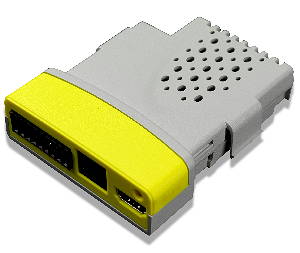Plug-in modules gives safety PLC functions to drives
![]() A programmable module that gives a drive similar functions to a safety PLC but at a much lower cost was one two plug-in modules launched by Control Techniques at the recent SPS/IPC/Drives show in Germany. The second module provides high-speed motion and registration control.
A programmable module that gives a drive similar functions to a safety PLC but at a much lower cost was one two plug-in modules launched by Control Techniques at the recent SPS/IPC/Drives show in Germany. The second module provides high-speed motion and registration control.
The SM-Safety module (shown below), for CT’s Unidrive SP AC drives and Digitax ST servodrives, provides programmable parameters for nine key safety functions including Safe Limited Speed, Position and Acceleration, and Safe Torque-off. Free software allows users to create bespoke safety protection zones.

CT product manager Imad RajRaji points out the machine designers and maintenance engineers often find it complex and costly to meet all relevant safety standards. “The SM-Safety module, which is effectively a mini safety PLC, simplifies the whole process and gives them complete peace of mind at a much reduced cost,” he says, adding that it can also boost performance.
The module has 18 I/O including four dual-redundant digital inputs, three safe digital outputs, and two inputs dedicated to encoders. It complies with the EN 61508, EN 62061, EN ISO 13849-1 and EN 61800-5-2 standards.
The second new option module, the SM-Register, is aimed at applications such as printing and packaging requiring accurate, high-speed registration. It offers motion programming using PLCopen or CT’s Advanced Position Controller languages at “a fraction” of the cost of standalone motion and registration controllers. It also eliminates delays between registration devices and drives.
The module offers seven modes of position capture, storage for 256 events per channel (separated by microseconds), pattern recognition, and the ability to filter unwanted marks, such as dirt or text. It can handle speeds of more than 1,000m/min.
A single connection point reduces wiring, while the module saves the space needed for external control devices and power supplies. It accepts inputs from most feedback devices, and supports EtherCat, Profibus, CANopen and other protocols.





